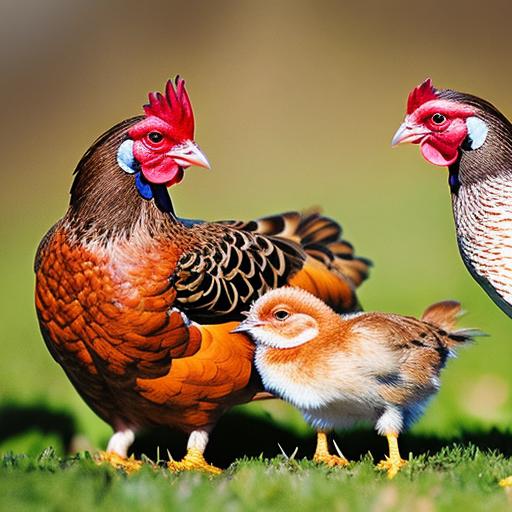Keeping chuckar and chickens together may seem like an unusual combination, but it can actually be a beneficial arrangement for both species. Chuckar, also known as chukar partridges, are small game birds native to Eurasia. They are often kept for hunting purposes or as pets. Chickens, on the other hand, are domesticated birds that are commonly raised for their meat and eggs.
The idea of keeping chuckar and chickens together may appeal to those who are looking to diversify their flock or create a more natural and dynamic environment for their birds. By combining these two species, you can introduce a new level of biodiversity to your flock and potentially reduce pest problems. Additionally, keeping chuckar and chickens together can make more efficient use of space, as both species have different habitat requirements.
Key Takeaways
- Keeping chuckar and chickens together is possible and can have benefits.
- Understanding the behavior of both species is crucial before attempting to keep them together.
- Factors such as space, temperament, and diet should be considered before integrating chuckar and chickens.
- Housing requirements for chuckar and chickens should provide separate areas for each species.
- Feeding requirements for chuckar and chickens differ, and care should be taken to ensure each species receives appropriate nutrition.
Understanding the behavior of chuckar and chickens
Chuckar and chickens have distinct differences in behavior that should be taken into consideration when keeping them together. Chuckar are known for their strong flight capabilities and prefer to spend their time on the ground, foraging for food. They are social birds that live in small groups called coveys. Chickens, on the other hand, are not strong fliers and spend most of their time on the ground as well. They are also social animals that live in flocks.
When chuckar and chickens are kept together, they may interact with each other in various ways. It is important to note that individual personalities and temperaments can vary among birds, so not all interactions will be the same. In general, chuckar and chickens may establish a pecking order within their respective species. This hierarchy helps maintain order within the flock and reduces aggression.
Factors to consider before keeping chuckar and chickens together
Before deciding to keep chuckar and chickens together, there are several factors that should be considered. First and foremost, space requirements must be taken into account. Both chuckar and chickens need ample space to roam and forage. It is recommended to provide at least 10 square feet of space per bird to ensure they have enough room to move around comfortably.
Compatibility of breeds is another important factor to consider. Some chicken breeds may be more compatible with chuckar than others. It is best to choose chicken breeds that are known for their docile and non-aggressive nature. Additionally, it is important to consider the size difference between chuckar and chickens. Chuckar are smaller in size compared to most chicken breeds, so it is crucial to ensure that the chickens do not pose a threat to the chuckar.
Potential risks should also be taken into consideration when keeping chuckar and chickens together. There is a risk of disease transmission between the two species, so it is important to monitor their health closely and take necessary precautions to prevent the spread of diseases. Additionally, there may be a risk of aggression between the two species, especially during the initial introduction phase. Proper integration techniques should be followed to minimize conflict.
Housing requirements for chuckar and chickens
When it comes to housing requirements, there are several options that work well for both chuckar and chickens. A spacious coop or aviary with separate areas for each species is ideal. This allows them to have their own space while still being able to interact with each other. The coop should be secure and predator-proof to ensure the safety of both species.
It is important to provide appropriate roosting areas for both chuckar and chickens. Chickens prefer elevated roosts, while chuckar prefer lower perches or platforms closer to the ground. Providing multiple roosting options will allow each species to choose their preferred spot.
Nesting boxes should also be provided for both chuckar and chickens. Chickens will use nesting boxes for laying eggs, while chuckar may use them for resting or nesting as well. The nesting boxes should be easily accessible and filled with suitable nesting material.
Feeding requirements for chuckar and chickens
Chuckar and chickens have different dietary requirements, so it is important to ensure that both species are getting the nutrients they need. Chickens are omnivores and require a balanced diet of grains, vegetables, fruits, and protein sources such as insects or commercial feed. Chuckar, on the other hand, are primarily herbivores and feed on a variety of seeds, grasses, and plant matter.
To meet the dietary needs of both chuckar and chickens, it is recommended to provide a combination of commercial feed and fresh foods. A high-quality game bird feed can be offered to chuckar, while a balanced chicken feed can be provided to chickens. Additionally, offering fresh fruits, vegetables, and insects can provide additional nutrients and enrichment for both species.
It is important to monitor the feeding habits of both chuckar and chickens to ensure they are eating adequately. If any signs of malnutrition or dietary deficiencies are observed, adjustments can be made to their diet accordingly.
Common health issues in chuckar and chickens

Both chuckar and chickens are susceptible to certain health issues that should be monitored closely. Common health issues in chuckar include respiratory infections, parasites, and nutritional deficiencies. Respiratory infections can be caused by bacteria or viruses and may result in symptoms such as coughing, sneezing, or difficulty breathing. Parasites such as mites or worms can also affect the health of chuckar if left untreated. Nutritional deficiencies can occur if their diet is not properly balanced.
Chickens are also prone to respiratory infections, parasites, and nutritional deficiencies. Additionally, they may be susceptible to conditions such as egg binding (difficulty laying eggs), bumblefoot (infection on the foot), or vent prolapse (protrusion of the cloaca). Regular health checks and proper preventative measures can help minimize the risk of these health issues.
Tips for integrating chuckar and chickens
Integrating chuckar and chickens requires careful planning and gradual introductions. Here are some tips to help facilitate a smooth integration:
1. Separate but visible: Initially, keep the chuckar and chickens in separate enclosures where they can see and hear each other. This allows them to become familiar with each other’s presence without direct contact.
2. Controlled interactions: Once the chuckar and chickens are comfortable with each other’s presence, supervised interactions can be introduced. This can be done by allowing them to free-range together in a controlled environment.
3. Gradual integration: Gradually increase the duration of their interactions over time. This allows them to establish a pecking order and reduces the risk of aggression.
4. Monitor behavior: Keep a close eye on the behavior of both species during the integration process. Look for signs of aggression or stress, and intervene if necessary.
5. Provide multiple resources: Ensure that there are ample food, water, and roosting areas for both chuckar and chickens. This helps reduce competition and potential conflicts.
Benefits of keeping chuckar and chickens together
Keeping chuckar and chickens together can offer several benefits for both species and the overall flock:
1. Increased biodiversity: By combining chuckar and chickens, you introduce a new level of biodiversity to your flock. This can create a more dynamic and natural environment for the birds.
2. Reduced pest problems: Chuckar are known for their foraging abilities and can help control pest populations such as insects or weeds. Chickens also contribute to pest control by eating insects and scratching the ground for pests.
3. Efficient use of space: By keeping chuckar and chickens together, you can make more efficient use of space. Both species have different habitat requirements, allowing you to utilize the same area for multiple purposes.
Potential drawbacks of keeping chuckar and chickens together
While there are benefits to keeping chuckar and chickens together, there are also potential drawbacks that should be considered:
1. Increased risk of disease transmission: Keeping different species together increases the risk of disease transmission. It is important to monitor the health of both chuckar and chickens closely and take necessary precautions to prevent the spread of diseases.
2. Potential for aggression between species: Chickens may exhibit aggressive behavior towards the smaller chuckar, especially during the initial introduction phase. Proper integration techniques should be followed to minimize conflict and ensure the safety of both species.
Conclusion and final thoughts on keeping chuckar and chickens together
Keeping chuckar and chickens together can be a rewarding and beneficial arrangement for both species. By understanding their behavior, providing appropriate housing and nutrition, and following proper integration techniques, you can create a harmonious environment for your flock. While there are potential risks and challenges, with proper care and attention, keeping chuckar and chickens together can be a successful endeavor. So why not give it a try and see the positive impact it can have on your flock?
If you’re considering keeping chuckar and chickens together, it’s important to provide them with a suitable coop that meets their specific needs. One option to consider is an A-frame chicken coop, which offers a compact and efficient design. To learn more about this type of coop and how it can benefit your chuckar and chickens, check out this informative article on Poultry Wizard: A-Frame Chicken Coop. Additionally, if you’re interested in exploring other coop options, such as a farmhouse chicken coop, Poultry Wizard has got you covered with another helpful article: Farmhouse Chicken Coop.
FAQs
What are chuckar and chickens?
Chuckar is a type of game bird that is commonly hunted for sport and food. Chickens, on the other hand, are domesticated birds that are commonly raised for their meat and eggs.
Can chuckar and chickens be kept together?
Yes, chuckar and chickens can be kept together in the same coop or pen. However, it is important to note that they have different dietary needs and may require different types of feed.
What are the benefits of keeping chuckar and chickens together?
Keeping chuckar and chickens together can provide a more diverse and interesting environment for both types of birds. Additionally, they can help control pests and weeds in the area where they are kept.
What are the potential drawbacks of keeping chuckar and chickens together?
One potential drawback of keeping chuckar and chickens together is that they may compete for resources such as food and water. Additionally, chuckar may be more aggressive than chickens and may harm or kill them if they feel threatened.
What should be considered before keeping chuckar and chickens together?
Before keeping chuckar and chickens together, it is important to ensure that they have enough space to move around and that their dietary needs are being met. Additionally, it may be necessary to separate them if they are not getting along or if one type of bird is being harmed by the other.
Meet Walter, the feathered-friend fanatic of Florida! Nestled in the sunshine state, Walter struts through life with his feathered companions, clucking his way to happiness. With a coop that’s fancier than a five-star hotel, he’s the Don Juan of the chicken world. When he’s not teaching his hens to do the cha-cha, you’ll find him in a heated debate with his prized rooster, Sir Clucks-a-Lot. Walter’s poultry passion is no yolk; he’s the sunny-side-up guy you never knew you needed in your flock of friends!







